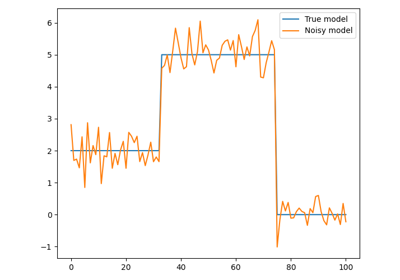pyproximal.RelaxedMumfordShah#
- class pyproximal.RelaxedMumfordShah(sigma=1.0, kappa=1.0)[source]#
Relaxed Mumford-Shah norm proximal operator.
Proximal operator of the relaxed Mumford-Shah norm: \(\text{rMS}(x) = \min (\alpha\Vert x\Vert_2^2, \kappa)\).
- Parameters
- sigma
floatorlistornp.ndarrayorfunc, optional Multiplicative coefficient of L2 norm that controls the smoothness of the solutuon. This can be a constant number, a list of values (for multidimensional inputs, acting on the second dimension) or a function that is called passing a counter which keeps track of how many times the
proxmethod has been invoked before and returns a scalar (or a list of)sigmato be used.- kappa
floatorlistornp.ndarrayorfunc, optional Constant value in the rMS norm which essentially controls when the norm allows a jump. This can be a constant number, a list of values (for multidimensional inputs, acting on the second dimension) or a function that is called passing a counter which keeps track of how many times the
proxmethod has been invoked before and returns a scalar (or a list of)kappato be used.
- sigma
Notes
The \(rMS\) proximal operator is defined as [1]:
\[\begin{split}\text{prox}_{\tau \text{rMS}}(x) = \begin{cases} \frac{1}{1+2\tau\alpha}x & \text{ if } & \vert x\vert \leq \sqrt{\frac{\kappa}{\alpha}(1 + 2\tau\alpha)} \\ \kappa & \text{ else } \end{cases}.\end{split}\]- 1
Strekalovskiy, E., and D. Cremers, 2014, Real-time minimization of the piecewise smooth Mumford-Shah functional: European Conference on Computer Vision, 127–141.
Methods
__init__([sigma, kappa])affine_addition(v)Affine addition
chain(g)Chain
grad(x)Compute gradient
postcomposition(sigma)Postcomposition
precomposition(a, b)Precomposition
prox(*args, **kwargs)proxdual(**kwargs)

